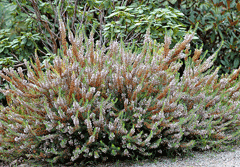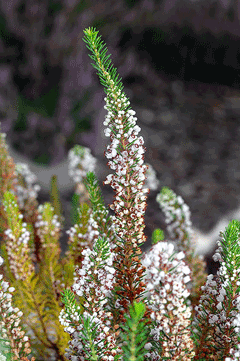 |
|
http://commons.wikimedia.org/wiki/User:Aka |
 |
| http://commons.wikimedia.org/wiki/User:Aka |
Translate this page:
Summary
Physical Characteristics

 Erica_vagans is an evergreen Shrub growing to 0.8 m (2ft 7in) by 0.8 m (2ft 7in).
Erica_vagans is an evergreen Shrub growing to 0.8 m (2ft 7in) by 0.8 m (2ft 7in).
See above for USDA hardiness. It is hardy to UK zone 5. It is in leaf all year, in flower from July to November. The species is hermaphrodite (has both male and female organs) and is pollinated by Bees, flies, Lepidoptera (Moths & Butterflies). The plant is self-fertile.
It is noted for attracting wildlife.
Suitable for: light (sandy) and medium (loamy) soils, prefers well-drained soil and can grow in nutritionally poor soil. Suitable pH: mildly acid and neutral soils and can grow in very acid soils.
It cannot grow in the shade. It prefers dry or moist soil. The plant can tolerates strong winds but not maritime exposure.
UK Hardiness Map
US Hardiness Map
Synonyms
Plant Habitats
Edible Uses
References More on Edible Uses
Medicinal Uses
Plants For A Future can not take any responsibility for any adverse effects from the use of plants. Always seek advice from a professional before using a plant medicinally.
None known
References More on Medicinal Uses
The Bookshop: Edible Plant Books
Our Latest books on Perennial Plants For Food Forests and Permaculture Gardens in paperback or digital formats.

Edible Tropical Plants
Food Forest Plants for Hotter Conditions: 250+ Plants For Tropical Food Forests & Permaculture Gardens.
More

Edible Temperate Plants
Plants for Your Food Forest: 500 Plants for Temperate Food Forests & Permaculture Gardens.
More

More Books
PFAF have eight books available in paperback and digital formats. Browse the shop for more information.
Shop Now
Other Uses
A dye is obtained from the flowers. No further details. The twigs are used for making brushes, thatching, bedding etc and also as a fuel. A good ground cover plant, though it might need weeding for the first year[197]. It can be clipped in spring to give denser growth[197, 208]. Space the plants about 60cm apart each way[208].
Special Uses
References More on Other Uses
Cultivation details
A calcifuge plant, it requires a light lime-free loam[11]. Grows well on sunny slopes, thriving in any soil that is not heavy or alkaline[11]. Plants can succeed in a slightly alkaline soil if it is rich in humus according to some reports[182, 188]. Grows best in a poor soil[11]. Resents dry soils. Prefers an open situation. A very ornamental plant[1], there are many named varieties[182]. A food plant for the caterpillars of many species of butterflies and moths as well as providing a food source for the moths and butterflies[30]. Plants in this genus are notably resistant to honey fungus[200]. In garden design, as well as the above-ground architecture of a plant, root structure considerations help in choosing plants that work together for their optimal soil requirements including nutrients and water. The root pattern is branching: a heart root, dividing from the crown into several primary roots going down and out [2-1].
References Carbon Farming Information and Carbon Sequestration Information
Temperature Converter
Type a value in the Celsius field to convert the value to Fahrenheit:
Fahrenheit:
The PFAF Bookshop
Plants For A Future have a number of books available in paperback and digital form. Book titles include Edible Plants, Edible Perennials, Edible Trees,Edible Shrubs, Woodland Gardening, and Temperate Food Forest Plants. Our new book is Food Forest Plants For Hotter Conditions (Tropical and Sub-Tropical).
Shop Now
Plant Propagation
Seed - surface sow in an acid sandy compost in a cold frame in spring. Keep moist. Prick out the plants as soon as they are large enough to handle and plant them in their permanent positions when they are 5 - 8cm tall[11]. Cuttings of half-ripe wood, 3cm long taken from twiggy lateral growths near the base of the plant, July/August in a frame. Remove the leaves from the bottom part of the stem without causing any damage to the bark. The cuttings root in a few weeks if they are given some bottom heat. Plant out in spring[11]. Layering in spring or autumn. Plants can be 'dropped' and then dug up and divided about 6 - 12 months later. Dropping involves digging up the plant and then replanting it about 15 - 20cm deeper in the soil to encourage roots to form along the stems[78].
Other Names
If available other names are mentioned here
Native Range
EUROPE: United Kingdom (southwest), Spain, France
Weed Potential
Right plant wrong place. We are currently updating this section.
Please note that a plant may be invasive in one area but may not in your area so it’s worth checking.
Conservation Status
IUCN Red List of Threatened Plants Status :

Growth: S = slow M = medium F = fast. Soil: L = light (sandy) M = medium H = heavy (clay). pH: A = acid N = neutral B = basic (alkaline). Shade: F = full shade S = semi-shade N = no shade. Moisture: D = dry M = Moist We = wet Wa = water.
Expert comment
Author
L.
Botanical References
1117200
Links / References
For a list of references used on this page please go here
Readers comment
| Add a comment |
|
If you have important information about this plant that may help other users please add a comment or link below. Only comments or links that are felt to be directly relevant to a plant will be included. If you think a comment/link or information contained on this page is inaccurate or misleading we would welcome your feedback at [email protected]. If you have questions about a plant please use the Forum on this website as we do not have the resources to answer questions ourselves.
* Please note: the comments by website users are not necessarily those held by PFAF and may give misleading or inaccurate information.
To leave a comment please Register or login here All comments need to be approved so will not appear immediately.
|
|